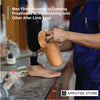VA Engineers Create Prosthetic Hook Mouse
As computers continue to be a staple in our daily lives, VA engineers created a prosthetic hook mouse for people with upper-limb amputations to make navigating a computer more manageable than before. The device's invention is a part of the Human Engineering Research Laboratories (HERL), a collaborative effort between the VA Pittsburgh Healthcare System and the University of Pittsburgh.

In a nutshell, HERL researchers are tasked with developing various assistive technologies. They also use advanced 3D printers to design and create these assistive devices.
The idea for the prosthetic hook mouse came to Dr. Rory Cooper, HERL director and a bioengineer, while attending the 2018 National Disabled Veterans Winter Sports Clinic in Colorado. He met Dave Riley, an Army and Coast Guard veteran and a former national commander of Disabled American Veterans, the veterans' service organization.
Riley is a quadruple amputee who used prosthetic hooks on his upper limbs. He is also a computer scientist who told Dr. Cooper that he would appreciate it if he could use a computer mouse compatible with his prosthetic hook.
As soon as he returned to Pittsburgh, Dr. Cooper and a few of his colleagues set out to find a solution for Riley's problem. To understand the plight of upper-limb amputees better, Dr. Cooper talked to a prosthetist, who made a prosthetic socket for the hook. Then, they set to find the shape that's most compatible with a prosthetic hook and a mouse by drawing up figures on a computer and 3D printing them. They soon found a shape that worked well.
During the 2019 National Disabled Veterans Winter Sports Clinic, Dr. Cooper and his team revealed the prototype of their new invention. The device was shaped like a pyramid. It had an elevation at the back, which provided space for a user to rest the wrist area of their prosthetic arm.
Meanwhile, in the front, the prosthetic hook can drag a cursor and click left and right. Riley was one of the few testers who tried the mouse, and he found it mobile—precisely like a conventional computer mouse. Riley offered his feedback on improving the device, including tightening an area that would give the prosthetic hook more control while moving the cursor.
During this time, the research team realized they needed to accommodate left-hand prosthetic arm users. They also found out that prosthetic hooks came in three sizes. They revised the device based on initial feedback and came up with three patents on the computer mouse—one for right-handed people, one for left-handed people, and one for a device compatible with different hook sizes.
As of April 2021, more than 100 prosthetic mice have been 3D-printed. These have been sent to the Walter Reed National Military Medical Center in Maryland, the Center for the Intrepid at Brooke Army Medical Center in Texas, and the James A. Haley Veterans Hospital in Florida. Most of those who have used the prosthetic mice said that the device gave them more control of their computer.
HERL is currently working with VA's Technology Transfer Program to license prosthetic mice and allow manufacturers to create and sell the device to the public.
What do you think of this device? Would you get one as soon as it's available for sale?









































































